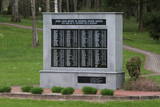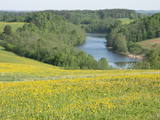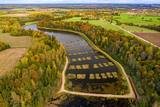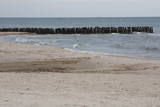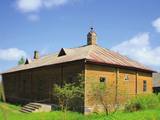| Нo | Название | Описание |
|---|---|---|
|
The viewing tower was built quite recently. At its foot is a location for relaxation. It offers a good view of one of the curves of the Daugava River – the Adamova curve. A bit beyond is the Curves of Daugava Nature Park. Along the tower is the “Saulkrasti Trail” bicycle route.
|
||
|
Пивной погреб «Мара» находится в Талси. Количество мест: 100, в летний сезон - 200. Время работы: пн. – вс. с 11:00 до 23:00; с мая до сентября пивной сад: 10:00 - 02:00 |
||
|
Во время Второй мировой войны, в конце сентября 1944 года в Море завершилось одно из кровопролитных и жестоких сражений на территории Латвии, безжалостнее которого была только ликвидация Курземского котла. В битве при Море сражавшиеся на немецкой стороне латышские легионеры задержали прорыв Красной армии к Риге и предотвратили окружение военных сил 18 немецкой армии. Исход битвы был важен для гражданских жителей (> 100 000), которые могли и успели в качестве беженцев спастись от последующих репрессий. Ежегодно в сентябре месяце в парке проходят мероприятия, посвященные памяти сражений, которые собирают очевидцев и сочувствующих тех событий. Здесь открыта мемориальная плита с высеченными известными именами павших в сражении при Море легионеров и установлен высеченный в камне крест – в знак памяти павшим неизвестным бойцам. В 2 км на восток от парка создан музей, где установлен танк Советской армии.
|
||
|
Seno un mūsdienīgo amatu prasmju popularizēšana, izkopšana un tālāknodošana. |
||
|
Pusceļā starp Madonu un Cesvaini, Sarkaņu pagasta Biksēres “Jaundilmaņos” dzimis Latvijas Bērnu ķirurģijas pamatlicējs, traumatalogs un ortopēds, izcils bērnu ārsts Aleksandrs Bieziņš (1897.-1975.). Tagad viņa dzimtajās mājās ierīkots muzejs, Paula Stradiņa Medicīnas vēstures muzeja filiāle. |
||
|
Meklējama pilsētas centrā - Tirgus laukumā 11. Dievnams uzcelts 1886. g. Ēkā atrodas vairāki nozīmīgi mākslas pieminekļi – gleznas, krucifikss (18. gs.) u.c. Baznīcas dārzā apskatāma skulptūra “Latgales māte” (tēlnieks B. Buls) un piemineklis politiski represēto piemiņai (tēlniece V. Dzintare). Baznīca ir apskatāma arī no iekšpuses. |
||
|
This nature park is located in the most distinct part of the Dagda hillocks of the Latgale highlands. Part of it is the deepest lake in the Baltic States -- Lake Drīdzis, which is 63.1 metres deep and has nine islands. Also there is Lake Otis. The loveliest views can be watched from the ancient Lettigalian castle hill that is known as Sauleskalns, and from the eastern shores of Lake Drīdzis. Accommodations are available near the lake. |
||
|
Liellopu izsoļu nams ir vienīgais liellopu izsoļu nams Baltijā. Izsoles tiek rīkotas gaļas šķirņu jaunlopiem - buļļiem un telēm vecumā līdz 12 mēnešiem, regulāri - divas reizes mēnesī. Katru mēnesi izsolēs piedalās vairāk kā 2000 Latvijā audzēti jaunlopi. |
||
|
Iespēja patīkamā atmosfērā baudīt ļoti gardu ēdienu. . Starp tiem arī Lietuviešu tradicionālo ēdienu. Ir dienas un vakara īpašie piedāvājumi. |
||
|
Volzbahs ir stāva nogāze ar elpu aizraujošu skatu pāri gravai. Ziemā šeit pieejams vairāk nekā 100 m garš nobrauciens ar slēpēm, sniega dēli vai ragaviņām. Citos gadalaikos Volzbaha kalns ir lieliska atpūtas vieta- šeit ir labiekārtota vieta piknikam, pastaigām, foto sesijām. Rudenī Volzbaha kalns ir viena no labākajām vietām Vaiņodes novadā, kur vērot krāšņos rudens skatus. Volzbahs atrodas 2 km no Vaiņodes centra ZR virzienā. Kalnam ērti var piebraukt klāt ar automašīnām. Adrese: Vaiņodes pagasts, Dienvidkurzemes novads, LV-3435 Facebook: facebook.com/biedribavolzbahs Twitter: Volzbahs |
||
|
Находится на кладбище Бертуля. Создан по проекту Л. Швалбе. На лицевой стороне памятника помещена бронзовая плита с надписью «С глубокой благодарностью за Латвию павшим народным героям. 10-ое Руйиенское отделение Даугавас ванаги». На тыльной стороне памятника находится надпись «Бог, Отечество, Народ». Памятник был восстановлен в 1989-м году. |
||
|
Кафе «Иевиня» находится в историческом центре Тукумса. Предлагаются латышские лакомства - булочки, открытые пироги и пироги. |
||
|
В хозяйстве создана современнейшая в Балтии кроличья ферма. Кролики живут в кроличьих баньках, а снаружи – в смотровых вольерах. Дети могут познакомиться с 24 породами кроликов и осмотреть окрестности со смотровой вышки. По предварительной договоренности – покупка свежей крольчатины, колбас, копченостей и паштета. Новинка – венгерские дикие свини Мангалица. |
||
|
Ирбский пролив - очень важная территория в период миграции птиц. Наиболее встречаемые охраняемые породы птиц - темная утка, черная утка, морянка, малая чайка, краснозобая и чернозобая гагара, а также чистик обыкновенный. Территория находится напротив Дундагского и Вентспилсского края, занимает площадь в 172 412 га.
|
||
|
В хозяйстве занимаются животноводством, выращиванием фруктов, овощеводством, производством и переработкой мяса и молока. Договорившись заранее, можно купить разную домашнюю продукцию, научиться вязать сыр, испечь свой хлеб по рецептам предков. Одно из хозяйств кулинарного наследия Латгалии. |
||
|
На восстановленной в 20-е годы ХХ столетия (возобновила работу в 1992 г.) водяной мельнице можно осмотреть исторические механизмы и понаблюдать за процессом помола, а в кафе побаловать себя блинчиками, испеченными из намолотой муки. Латышская кухня: Селедка с творогом и вареным картофелем. Блины с грибами, сыром, овощами, мясом, медом, сметаной, творогом, мороженым и карамелью. |
||
|
Остронский (Устронский) Римско-католический костёл
Св. Алоиза был построен в 1935 году первым деканом прихода
Б. Валпитром на участке, подаренном приходу Я. Пушмуцовым.
|
||
|
Netālu no augstākā Latgales augstienes paugura – Lielā Liepukalna atrodas zemnieku saimniecība, kuras darbnīcā amatnieks Jānis Kuzminskis taisa mūsdienīgas ģitāras u.c. mūzikas instrumentus. Apmeklētāji var iepazīt Jāņa veidoto ekspozīciju, vērot amatnieka darbošanos, pasūtīt sev jaunu instrumentu, kā arī muzicēt pie bagātīgajā kolekcijā savāktajiem instrumentiem. Saimniece stāsta par Latgales kulinārā mantojuma ēdieniem un rāda, kā gatavo gulbešnīkus. |
||
|
The “Zoltners” restaurant offers dainty dishes from fresh seasonal products. The key philosophy of the menu is staying natural and unsophisticated. Endijs Vīnerts, the restaurant chef, has a special approach to create the combinations of tastes that are characteristic to North Europe and to discover new nuances of the tastes of local products. |
||
|
"Līdumkalni" atrodas Ķurbē -Kurzemes ziemeļrietumu daļā, starp Dundagas mežiem un Ķurbes lielo silu, zaļu pakalnu vidū, 15 km no jūras un ne pārāk tālu no debesīm. Šeit laiks rit lēni. Tas nevienu nesteidzina. Laika pietiek, lai vērotu Dieva radīto pasauli un ieskatītos Viņa bagātajā aptiekā. Laika pietiek lai iepazītos ar kristīgajām tradīcijām un dzīvesveidu, lai iegūtu praktisku lūgšanu un meditāciju pieredzi. Laika pietiks arī veselīgas maltītes pagatavošanai lauku virtuvē vai uz ugunskura un pašam savas gleznas uzgleznošanai gleznotājas darbnīcā. |
||


